New Haven (8 of 9)
There are nine Amistad sites in New Haven as of 2/14/2011.
1. Amistad Memorial
165 Church Street, New Haven, CT
Sculpted by Ed Hamilton in 1992, this monument of Sengbe Pieh, known as Joseph Cinqué, stands on the former site of the New Haven Jail, where illegally kidnapped Africans were imprisoned in 1839 while awaiting trial. The work is a majestic, 14-foot relief sculpture cast in bronze, and distinguished by its unique three-sided form, each side highlighting the capture, trial and return home of Cinqué and his fellow captives.
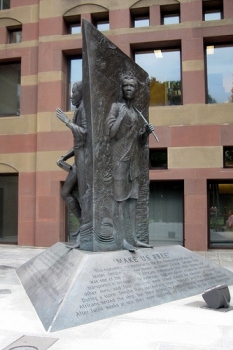
This picture is from This Flickr set, because mine (as you see below) were all washed out.
The sculpture is set off the road in a sort of alcove of the New Haven City Hall. The inscription on it is worth noting, so here it is:
“Make Us Free”
This monument is a memorial to the 1839 Amistad Revolt and its leader, Sengbe Pieh, also known as Joseph Cinque. Sengbe Pieh was one of the millions of Africans kidnapped from their homes and transported in bondage to the Americas. Sold into slavery in Cuba, he and forty-eight other men, and four children were bound aboard the schooner La Amistad. During a storm, Sengbe Pieh  successfully freed himself and his fellows. The Africans seized the ship, but their offers to steer La Amistad homeward were thwarted. After futile weeks at sea, they were captured off Long Island by the U.S.S. Washington.
successfully freed himself and his fellows. The Africans seized the ship, but their offers to steer La Amistad homeward were thwarted. After futile weeks at sea, they were captured off Long Island by the U.S.S. Washington.
On this site, the Amistad Africans were jailed awaiting trial for piracy and murder. To aid their struggle for freedom, the Amistad Committee formed, counting in its number ministers Simeon Jocelyn, Joshua Leavitt, and James Pennington; merchant Lewis Tappan; professor Josiah Gibbs; and lawyer Roger Baldwin. The Africans were tried twice prior to their ultimate triumph before the United States Supreme Court, where former President John Quincy Adams courageously defended them. Sengbe Pieh and his fellows were declared Free Persons.
The Africans sought to return home. To raise funds for their voyage and to further the anti-slavery cause, they engaged in a series of speaking tours. In 1841, after a sojourn that profoundly influenced the abolitionist movement, they set sail, free at last.
To commemorate the heroism of the Amistad Africans and those who shared in their quest for freedom, the 1989 Amistad Committee commissioned his sculpture by Ed Hamilton and dedicated it on September 26, 1992.
…………………………………………………….
2. Battell Chapel
Yale University Divinity School
This one doesn’t appear on all the Amistad Trail literature, but since it does appear on one, I’ll include it. If only because the building is pretty darn cool. Here’s a history of it.
Update: With the new Freedom Trail website in early 2011, I can now add from there: “Battell Chapel represents the role that Yale Divinity School faculty and students played in assisting the Mende Africans of La Amistad, and offers an exhibition of relevant materials maintained by Yale.”
…………………………………………………….
3. Center Church
250 Temple Street, New Haven, CT
Founded in 1639, the original building was replaced by the current structure, built in 1812. A companion cemetery contains graves from the 17th century. During the Amistad incident in the mid 19th century, the congregation of this church was particularly instrumental in gaining support for the Africans, who were being held in the New Haven Jail. The property is a National Historic Landmark. (CTMQ’s attempt to complete that list here.)
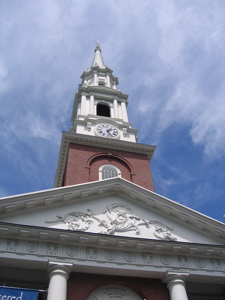
My visit here, and to its cool crypt
…………………………………………………….
4. Freedom Schooner Amistad
Long Wharf Pier
Currently at sea and therefore, not yet visited.
…………………………………………………….
5. Grove Street Cemetery
227 Grove Street
At the time of this writing, Grove Street Cemetery appears on both the Freedom Trail AND the Amistad Trail according to the brand new (as of 2/15/11) website. So… I guess I’ll do what they did and post the same blurb on both. This is also a National Historic Landmark
 Let’s begin with the Freedom Trail brochure’s little blurb:
Let’s begin with the Freedom Trail brochure’s little blurb:
“This cemetery opened in 1796 and replaced the Old Burial Ground located on the New Haven Green. Many New Haven residents who were well known in American life are buried here. The cemetery includes the graves of those active in the abolition movement, as well as those associated with African American history.”
No offense, but that really sells this place short. Just perusing the cemetery’s website alone, there is a TON of cool information to read. Keeping in the spirit of these somewhat short Freedom Trail blurbs, I’ll provide mostly links. Or, you can also read more over at the slightly more detailed page I put together regarding its status as a National Historic Landmark. (Go here).
Hey, look at this! Grove Street Cemetery is the first chartered burial ground in the United States. I guess that warrants a tour of the joint (which looks very interesting) and another post for being the oldest of something in the country. The first burial, that of Martha Townsend, took place on November 9, 1797.
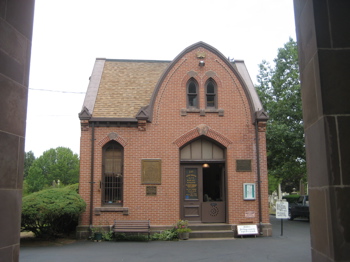 The pattern of the cemetery also appears to have been unique, for it was arranged in lots for families as opposed to random burials which had been common in the past. The grounds were also divided to give space to parishioners of the three churches on the Green, an area for strangers who might die in New Haven, one for the indigent, a section for persons of color and one for Yale College.
The pattern of the cemetery also appears to have been unique, for it was arranged in lots for families as opposed to random burials which had been common in the past. The grounds were also divided to give space to parishioners of the three churches on the Green, an area for strangers who might die in New Haven, one for the indigent, a section for persons of color and one for Yale College.
It’s the part about “persons of color” that gets the cemetery onto the Freedom Trail. Aside from the world-famous buried here (Eli Whitney, Noah Webster, Walter Camp), there are many graves of important African-Americans and those who fought for their humanity: Mary A. Goodman, the African-American woman who gave her life savings to Yale Divinity School to educate African-American clergy, is buried here along with African-American Civil War veterans. Roger Sherman Baldwin who argued the case for the Amistad slaves imprisoned in New Haven, and Professor Josiah Willard Gibbs, Sr. who deciphered the language spoken by the captives are also here.
A stone marker was dedicated by the Amistad Committee in September 2001 in remembrance of the six Mende African captives of La Amistad buried here.
Grove Street Cemetery
Tours
Detailed history
…………………………………………………….
6. Long Wharf
Long Wharf Drive, New Haven, CT
One of the oldest ports in the United States, Long Wharf has been active since the earliest days of New Haven’s existence. Before the advent of rail lines and steamships, Long Wharf was a major port of entry for both imports and immigrants. Long Wharf has been designated as the home port for the life-size replica of the ship Amistad, which will sail from its base to other ports periodically.
I had a few pictures taken along Long Wharf Drive (at speed) after a trip to IKEA. The Amistad isn’t in town now, so they all sort of looked like this anyway.
…………………………………………………….
7. New Haven Museum
114 Whitney Avenue, New Haven, CT
Located in New Haven’s historic downtown, the New Haven Museum and Historical Society offers visitors the opportunity to explore the city and region’s people, places and events from the Quinnipiac Indians to the present day. There is an exhibit that showcases the largest collection of Amistad related artwork in the world. The gallery chronicles the events of the 1839 revolt and subsequent legal case that was one of the defining moments in anti-slavery movement. Made famous by a 1997 Hollywood movie, the true story of the Amistad can be found here. Argueably one of the most unique portraits in America, Nathaniel Jocelyn’s Portrait of Joseph Cinque, captures the poetic struggle of two cultures working together for freedom and justice.
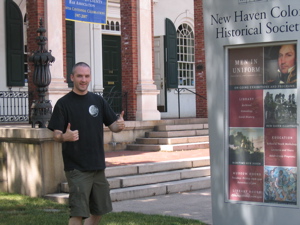
…………………………………………………….
8. Roger Sherman Baldwin Law Office Site
123 Church Street
Just like the Grove Street Cemetery, this one is showing up on both trails. Enjoy the same words here as there.
 I’ve driven and walked past this Freedom Trail site probably 30 times – and I don’t even live in New Haven. So imagine my (slight) surprise when I made the point to walk right up to 123 Church Street (now a bank) and found a handsome plaque dedicated to the former law office? The two chilled women waiting for a bus were decidedly nonplussed about my find. I should have asked them (they were black) if they knew the history of the spot they were standing – for it’s rather important:
I’ve driven and walked past this Freedom Trail site probably 30 times – and I don’t even live in New Haven. So imagine my (slight) surprise when I made the point to walk right up to 123 Church Street (now a bank) and found a handsome plaque dedicated to the former law office? The two chilled women waiting for a bus were decidedly nonplussed about my find. I should have asked them (they were black) if they knew the history of the spot they were standing – for it’s rather important:
Roger Sherman Baldwin (1793-1863), New Haven lawyer and abolitionist, represented the Amistad captives before the U.S. Circuit and District Courts in Connecticut, 1839-1840. With John Quincy Adams, he won freedom for the captives before the U.S. Supreme Court in 1841. Baldwin was the grandson of Roger Sherman (1721-1793), a signer of the Declaration of Independence and the author of the Connecticut Compromise at the Constitutional Convention. Roger Sherman Baldwin served terms in the Connecticut Senate, the Connecticut House of Representatives, and the U.S. Senate; he was also Governor of Connecticut from 1844 to 1846.
Now, you can’t help but come across Amistad stuff on CTMQ, notably in New Haven and Farmington. Heck, an adjunct trail to the Freedom Trail is the Amistad Trail, which CTMQ is completing as well.
And you darn well know the Roger Shermans certainly crop up here and there. It’s really quite amazing to stop at the corner of the New Haven Green here at this site (yes, with a Starbucks across the street) and contemplate all the history that lay before you. Books have been written on the subject and I have had great fun uncovering all the pieces along my way.
…………………………………………………….
9. United Church on the Green
323 Temple Street
 This church is right next to the Center Church seen above. They look very similar and as a result, I was always confused as to which was which. So one day, when I was in New Haven for the 1000th time, I decided to go and sort it out. I even took a picture and am now quite happy that I have pictures of the two different churches.
This church is right next to the Center Church seen above. They look very similar and as a result, I was always confused as to which was which. So one day, when I was in New Haven for the 1000th time, I decided to go and sort it out. I even took a picture and am now quite happy that I have pictures of the two different churches.
But what makes the United Church different from the Center Church? Let’s turn to the Trail people:
This building was originally known as the North Church (Congregational), which merged with the Third Church (Congregational) in 1884 to create the United Church. Several members of the two earlier congregations were abolitionists who also assisted New Haven’s free black community. They included Roger Sherman Baldwin, Nathaniel and Simeon Jocelyn and the Reverend Samuel Dutton. Baldwin, a lawyer, was active in the defense of the Mende Africans and is commemorated by a plaque inside the church. The church is included in the New Haven Green National Historic Landmark District.
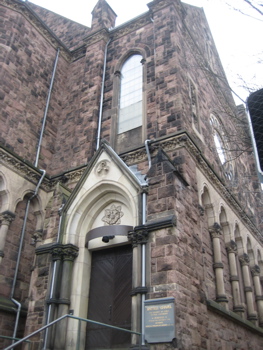

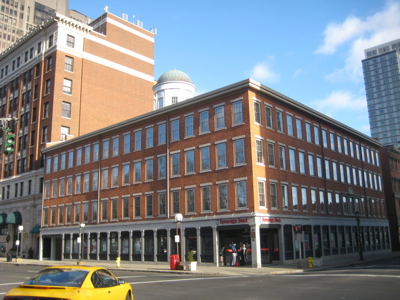






came across your posting and photos while searching info on early New Haven, in particular 1835-1860 my Great (x4) Uncle George Story born and raised there. I believe but yet to verify that the bldg at 123 Church & Chapel St was where he first apprenticed as a ships figurehead carver c1851. 3rd floor his notes say. Trying to develop a series of stories about him for performance.
Comment #1 on 11.23.12 at 10:35 pm